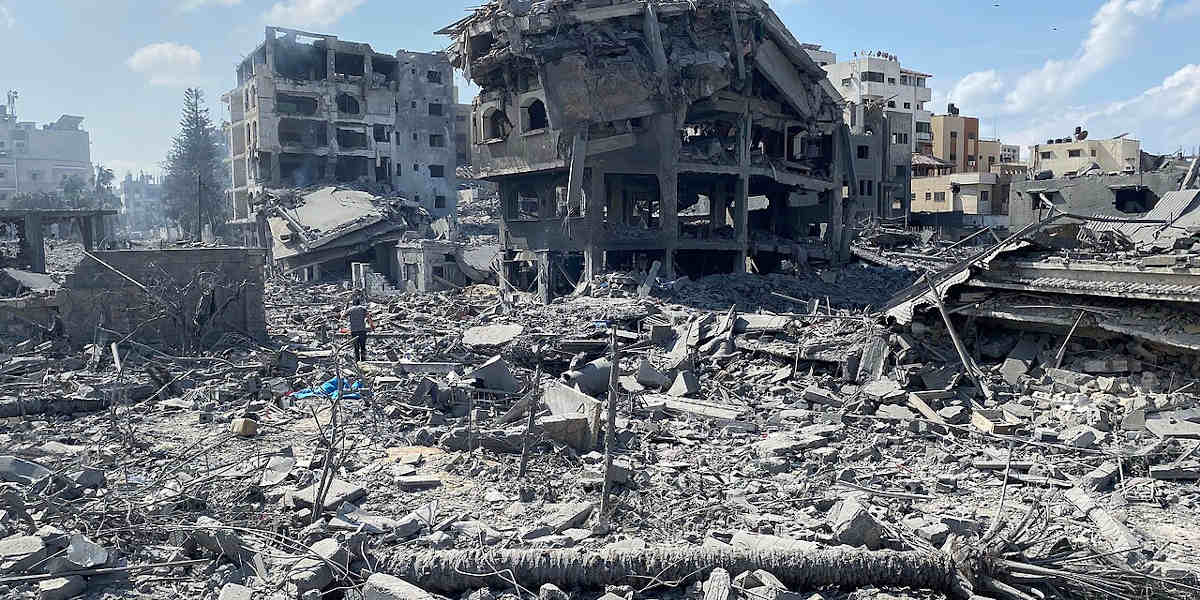In the past several months, the destruction of infrastructure has been central to the Israeli offensive on Gaza. More than half of all residential homes have been destroyed. Three quarters of Gaza’s schools, colleges, and universities have been reduced to rubble. Attacks on medical infrastructures have been systematic and targeted, leaving just 15 of Gaza’s 36 hospitals partially functioning. Potable water no longer circulates through treatment and desalination plants because fuel shortages have shut them down. Pipes filled with sewage are blasted apart and spill their contents into the surrounding soil, leading international aid agencies to warn of looming cholera outbreaks.
Meanwhile much of the strip is shrouded in an electricity and communications blackout, plunging streets into darkness and cutting Gaza off from the outside world. Road networks that once ensured the arrival of humanitarian aid and foodstuffs no longer function, forcing nearly 2 million displaced people to move by foot or on donkey-drawn carts. In Gaza, the decimation of infrastructure has been transformed into a weapon of war.
On 11 January 2024, Adila Hassim, advocate of the high court of South Africa, made the argument in front of the International Court of Justice that the conduct of the Israeli state followed a pattern of genocidal intent. She pointed specifically to the destruction of infrastructure in support of her case: ‘Depriving Palestinians in Gaza of basic needs – food, water, health care, fuel, sanitation, and communications,’ Hassim explained. ‘Destroying social infrastructure, homes, schools, mosques, churches, hospitals, and killing, seriously injuring, and leaving large numbers of children orphaned’.
The devastation has been so extensive that hitherto academic concepts such as ‘urbicide‘ and ‘domicide‘ are gaining increased credence with experts in international law. Sharing a root with genocide, these terms respectively join the destruction of urban infrastructure and of residential domiciles to deliberate attempts to erase communities based on their cultural and ethnic identities. They highlight how destruction not only of people but of place is used as an instrument of genocide.
infrastructure and slow violence
Modern infrastructure has its origins in warfare and colonial conquest. From Napoleon’s military supply chains to the railways that fuelled the expansion of the British Empire, infrastructure was developed to enable the logistical movement of soldiers and weapons to frontiers where they were used to occupy and settle colonial territories. The destruction of existing infrastructure is the other arm of this colonial process. By pulling apart the life-support systems of colonised communities, the way is cleared for continued settlement.
A tradition of anti-colonial and abolitionist writing has long recognised the deadly stakes of infrastructure. Observing the settler colonial city of Algiers in the mid-twentieth century, the revolutionary psychiatrist Frantz Fanon described the sharp contrast between the functioning infrastructure of the colonial city and the decimated infrastructure of the colonised quarters. In his account, the settlers enjoy a clean landscape of smooth roads under an electrified sky; the colonised meanwhile traipse through mud, living in shacks and unsanitary conditions that expose them disproportionately to disease and death.
By decimating the materials needed to sustain life, the assault on Gaza’s infrastructure furthers the Israeli right’s aim of preventing displaced Palestinians from ever returning to their homeland
More recently, abolitionist scholars such as Ruth Wilson Gilmore have shown that by moving people and things through space, infrastructures provide time through improved mobility and easier access to resources. Time is ‘the resource of life‘, explains Gilmore. Functioning infrastructure provides those who enjoy it with the potential for more life. Failing infrastructure, by contrast, meters out death. Whether infrastructures are destroyed slowly through blockades or quickly with bombs, their failure takes life away.
Palestinians living in the Occupied Territories know this ‘slow violence‘ all too well. Over decades, the West Bank has been carved into two proximate territories that are defined by their separate and unequal access to infrastructure. Israel’s continued construction of settlements operates alongside the targeted demolition of Palestinian homes, segregated road and transport systems, and uneven water and Wi-Fi connectivity. All of this extracts time from Palestinians as the resource of their lives.
Interrupting infrastructure
This slower infrastructural violence is insidious and virtually invisible in an international media that is dominated by the spectacle of ‘hot’ warfare. In response, groups such as Decolonizing Architecture, Forensic Architecture, and Visualising Palestine have innovated ways to make visible the enduring role of infrastructure in the occupation of both the West Bank and Gaza. By bringing the slower violence of road systems and house demolitions and water pollution into view, they provide crucial context for the quick violence of the current conflict.
Interrupting the infrastructure of the IDF’s war machine is therefore a means of peaceful resistance. In the UK, union workers have blockaded arms factories that are building and selling weapons to the Israeli state. This small but meaningful act intervenes into the global logistics infrastructure that makes the assault on Gaza possible. The many thousands taking to the streets to call for an end to the destruction articulate a similar politics of intervention: after all, a ceasefire would also interrupt the annihilation of what little infrastructure Gaza has left.
The events of the past months show up in the extreme the violent logic of infrastructure under settler colonialism. In Gaza, the targeting of infrastructure is a deliberate war aim. Its destruction by the Israel Defence Force is not ‘collateral damage’, but a vehicle for larger political ambitions. By decimating the materials that are needed to sustain life in both the present and the future, the assault on Gaza’s infrastructure furthers the Israeli right’s stated aim of preventing displaced Palestinians from ever returning to their homeland. The future of Palestinian life in Gaza will only be possible if this assault on its infrastructure comes immediately to an end.










